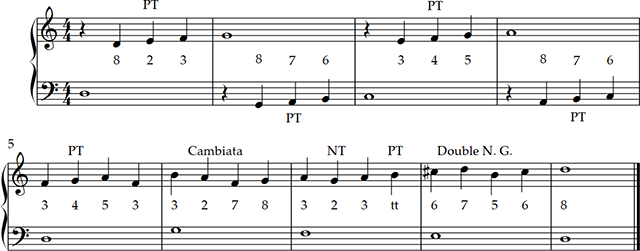Third Species Guidelines 4:1 (Strict)
Four notes in the counterpoint against one note in the cantus firmus is called strict third species. In the first measure, a rest may be used with the first note of the Cantus Firmus. The first note in the counterpoint is always a consonance with the CF. The notes that follow may be consonances or dissonances, but the first note on the strong beat always forms a consonance. On notes two and four of the counterpoint, the most common dissonances are the passing tone and the neighboring tone. Each dissonance may only be approached and left by a step, not a leap. In common time, beats 1 and 3 are typically consonant, and beats 2 and 4 may be passing or neighboring. If the notes on beats 1 and 2 are consonant, beat three may be a dissonance and step to a consonance on beat 4.
The two exceptions to these conventions are 4-note figures referred to as “changing tones” (nota cambiata) and the “double neighbor group.”
“Changing Tones” (nota cambiata)
In this figure, the first note is followed by a step down. The third note is a third down from the second note, and the fourth note is a step up. The second note is typically the only dissonance with the CF. The third note may be a dissonance when the interval sequence in the upper part is 5-4-2-3, or G-F-D-E over C. An example of the dissonance on the fourth note is the sequence 6-5-3-tt, or A-G-E-F# over C. Both the third and fourth notes are dissonant in the sequence 3-2-7-8, or E-D-B-C over C. Similarly, dissonances may appear in the lower part when the interval sequence is 3-4-6-tt, or D-C-A-B below F.
“Double Neighbor Group”
In this figure, the first note is followed by notes that are a second above and below it, forming a third in the middle. The third note is a third up or down from the second note, and the fourth note returns to the initial consonance. The second and third notes may both be dissonances with the CF. This is the case when the interval sequence in the upper part is 3-4-2-3, or E-F-D-E over C. The figure may be inverted to become 3-2-4-3, or E-D-F-E over C. The double neighbor group may appear above or below the CF and was more commonly used as ornamentation in keyboard or other instrumental music than in vocal music.

Examples of the Cambiata and Double Neighbor Group in two parts
Rules for Third Species (quarter-notes against whole notes, 4:1)
- Use consonances in general on the first and third notes in the counterpoint, with stepwise motion consisting of passing tones and neighboring tones between them.
- Two consecutive passing tones may be used on on the second and third notes.
- Approach and resolve each dissonance in stepwise motion, with the exception of the changing tone and double neighbor group figures.
- Avoid octaves and unisons with the CF on the first note of each 4-note group.
- The cadential formula typically ascends stepwise (6-7-8) to the doubled octave.
- Begin by converting first species to third species by adding divisions that move smoothly to the next consonance on the strong beat.
When writing examples of 3rd species, use whole notes in one part and quarter notes in the other part.

Typical patterns in 3rd species counterpoint.
